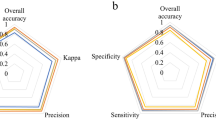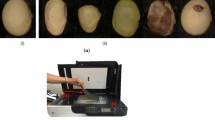Abstract
To obtain better productivity in soybean crops, it is essential to use high-quality seeds. The quality impacts the growing process of the plant. Currently, human specialists perform this quality control process through seed vigor analysis.It is not only a labor-intensive approach highly susceptible to failure, but also the analysts must understand seed anatomy. This paper proposes a learning-based expert approach and pipeline capable of automatically defining the seeds’ vigor. Our proposed approach simplifies, in an intuitive manner, the entire process of the seed vigor analysis. To corroborate our learning-based approach, we applied it in a real environment to capture, process, and use two real-world datasets composed of hundreds of soybean images with different damages from a seed classification laboratory. From the experiments, we can testify to a strong efficacy and efficiency in these real-world cases, reaching up to 80.17%±2.37 of accuracy. Our approach provides technological enhancements and opens new ways to solve the seed vigor definition regarding in-place image analysis, aggregating an entire on-the-fly seed analysis pipeline.







Similar content being viewed by others
References
Ali H, Lali MI, Nawaz MZ, Sharif M, Saleem BA (2017) Symptom based automated detection of citrus diseases using color histogram and textural descriptors. Comput Electron Agric 138:92–104
Al-Sharadqah AA, Ho DKC (2016) Solutions and evaluations for fitting of concentric circles. Signal Proc 120:468–479
Chollet F (2017) Xception: Deep learning with depthwise separable convolutions. In: 2017 IEEE Conference on Computer Vision and Pattern Recognition, pp 1800–1807
del Egido L, Navarro-Miró D, Martinez Heredia V, Toorop P, Iannetta P (2017) A spectrophotometric assay for robust viability testing of seed batches using 2,3,5-triphenyl tetrazolium chloride: Using hordeum vulgare l. as a model. Front Plant Sci 8(747):1–9
Deng J, Dong W, Socher R, Li L-J, Kai Li Li Fei-Fei (2009) ImageNet: A large-scale hierarchical image database. In: Proceedings of the IEEE Conference on Computer Vision and Pattern Recognition, IEEE, USA, pp 248–255
Franca-Neto JB, Krzyzanowski FC, da Costa NP (1998) The Tetrazolium Test for Soybean Seeds, pp. 1–72. Embrapa-CNPSo - Brazilian Corporation for Agricultural Research, Londrina
He K, Zhang X, Ren S, Sun J (2016) Deep residual learning for image recognition. In: Proceedings of the IEEE Conference on Computer Vision and Pattern Recognition, IEEE Computer Society, USA, pp 770–778
Howard AG, Zhu M, Chen B, Kalenichenko D, Wang W, Weyand T, Andreetto M, Adam H (2017) MobileNets: Efficient convolutional neural networks for mobile vision applications
Inacio Patricio D, Rieder R (2018) Computer vision and artificial intelligence in precision agriculture for grain crops: A systematic review. Comput Electron Agric 153:69–81
Jha D, Riegler MA, Johansen D, Halvorsen P, Johansen HD (2020) DoubleU-Net: A deep convolutional neural network for medical image segmentation
Kamalalochana S, Guptha N (2019) Optimizing random forest to detect disease in apple leaf. Int J Eng Adv Technol 8(5S):244–249
Kuhn M, Johnson K (2013) Applied Predictive Modeling. Springer, Berlin, Germany
Leist N, Kramer S (2011) ISTA Working Sheets on Tetrazolium Testing - Volume I and II. International Seed Testing Association, Wallisellen, Zurich
Liu W, Li W, Huang Y, Peng J (2017) Image retrieval by subspaceprojected color and texture features. In: Proceedings of the IEEE International Conference on Image Processing, pp 2891–2895
Meyer GE, Neto JC (2008) Verification of color vegetation indices for automated crop imaging applications. Comput Electron Agric 63(2):282–293
Nanni L, Paci M, Caetano dos Santos FL, Skottman H, Juuti-Uusitalo K, Hyttinen J (2016) Texture descriptors ensembles enable imagebased classification of maturation of human stem cell-derived retinal pigmented epithelium. Plos One 11(2):1–29
Narwade J, Kumar B (2016) Local and global color histogram feature for color content-based image retrieval system. In: Proceedings of the International Congress on Information and Communication Technology, Springer, Berlin, Germany, pp 293–300
Penatti OAB, Valle E, da S Torres R, (2012) Comparative study of global color and texture descriptors for web image retrieval. J Vis Commun Image Represent 23(2):359–380
Pereira DF, Bugatti PH, Lopes FM, Souza ALSM, Saito PTM (2019) Contributing to agriculture by using soybean seed data from the tetrazolium test. Data in Brief 23:103652
Pereira DF, Bugatti PH, Lopes FM, de Souza ALSM, Saito PTM (2021) Assessing active learning strategies to improve the quality control of the soybean seed vigor. IEEE Trans Ind Electron 68(2):1675–1683
Peters J (2010) Tetrazolium Testing Handbook. Association of Official Seed Analysts and Society of Commercial Seed Technologists, Moline, USA
Rehman T, Mahmud M, Chang Y, Jin J, Shin J (2018) Current and future applications of statistical machine learning algorithms for agricultural machine vision systems. Comput Electron Agric 156:585–605
Rocha DM, Nóbrega LHP, Bernardi D, Conti G, Nakajima EA, Ziech MF, Bazzi CL (2019) Random forests in the supervised classification of multidimensional images of the tetrazolium test. J Agric Sci 11(15):115–124
Russell SJ, Norvig P (2016) Artificial Intelligence: a Modern Approach. Pearson Education Limited, USA
Sandid F, Douik A (2016) Robust color texture descriptor for material recognition. Pattern Recognition Letters 80:15–23
Simonyan K, Zisserman A (2015) Very deep convolutional networks for large-scale image recognition
Stanitsas P, Cherian A, Li X, Truskinovsky A, Morellas V, Papanikolopoulos N (2016) Evaluation of feature descriptors for cancerous tissue recognition. In: Proceedings of the IEEE International Conference on Pattern Recognition, pp 1490–1495
Stehling RO, Nascimento MA, Falcao AX (2002) A compact and efficient image retrieval approach based on border/interior pixel classification. In: Proceedings of the International Conference on Information and Knowledge Management, pp 102–109
Strutz T (2016) Data Fitting and Uncertainty (A Practical Introduction to Weighted Least Squares and Beyond), 2nd edn. Springer, Berlin, Germany
Szegedy C, Vanhoucke V, Ioffe S, Shlens J, Wojna Z (2015) Rethinking the inception architecture for computer vision. In: Proceedings of the IEEE Conference on Computer Vision and Pattern Recognition, pp 2818–2826
Valenzuela G, Celebi ME, Schaefer G (2018) Color quantization using coreset sampling. In: Proceedings of the IEEE International Conference on Systems, Man, and Cybernetics, IEEE, USA, pp 2096–2101
Wolpert DH (1996) The lack of a priori distinctions between learning algorithms. Neural Comput 8(7):1341–1390
Yosinski J, Clune J, Bengio Y, Lipson H (2014) How transferable are features in deep neural networks? In: Proceedings of the International Conference on Neural Information Processing Systems, pp 3320–3328
Funding
This work has been supported by National Council for Scientific and Technological Development - CNPq [grant numbers \(\#431668/2016\)-7, \(\#422811/2016\)-5]; Coordination for the Improvement of Higher Education Personnel - CAPES; Fundação Araucária and UTFPR.
Author information
Authors and Affiliations
Contributions
\(\bullet \) Marcelo de Souza Jr.: Conceptualization, Methodology, Validation, Formal analysis, Data Curation, Software, Investigation, Writing - Original Draft
\(\bullet \) William C. Horikoshi: Conceptualization, Methodology, Validation, Formal analysis, Software
\(\bullet \) Priscila T. M. Saito: Conceptualization, Methodology, Writing - Original Draft, Writing - Review & Editing, Supervision, Project administration, Funding acquisition
\(\bullet \) Pedro H. Bugatti: Conceptualization, Methodology, Writing - Original Draft, Writing - Review & Editing, Supervision, Project administration, Funding acquisition
Corresponding author
Ethics declarations
Conflicts of interest
The authors declare that they have no conflict of interest
Additional information
Publisher's Note
Springer Nature remains neutral with regard to jurisdictional claims in published maps and institutional affiliations.
Rights and permissions
Springer Nature or its licensor (e.g. a society or other partner) holds exclusive rights to this article under a publishing agreement with the author(s) or other rightsholder(s); author self-archiving of the accepted manuscript version of this article is solely governed by the terms of such publishing agreement and applicable law.
About this article
Cite this article
Souza, M., Horikoshi, W.C., Saito, P.T.M. et al. Soybean seed vigor classification through an effective image learning-based approach. Multimed Tools Appl 83, 13113–13136 (2024). https://doi.org/10.1007/s11042-023-15804-0
Received:
Revised:
Accepted:
Published:
Issue Date:
DOI: https://doi.org/10.1007/s11042-023-15804-0




